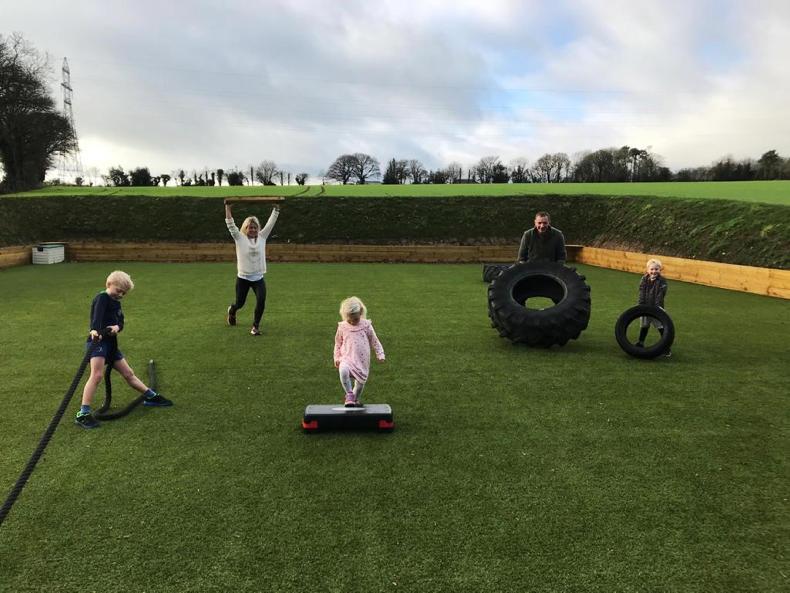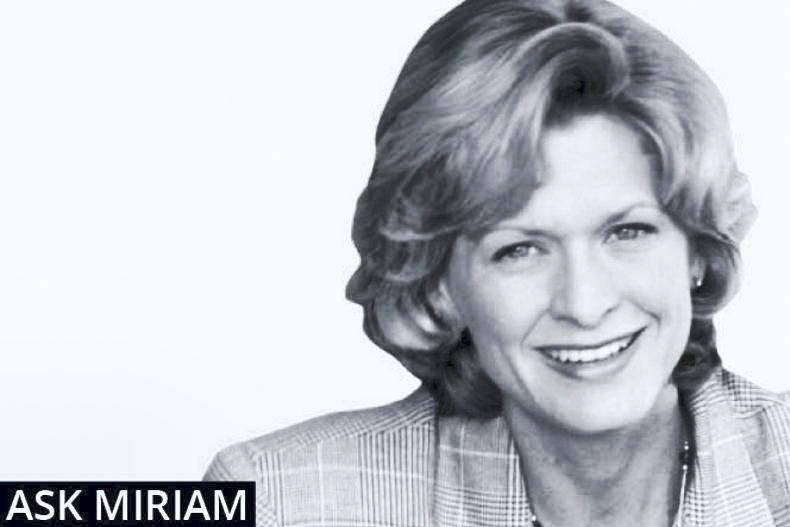With the new year here it’s time to think of making a healthy start. Have you ever thought of designing a simple training circuit on your farmyard, that the whole family can use?
Also, looking after your back as calving and lambing season starts is vital.
An exercise circuit in a field
near the farmhouse
Using small bales, old tyres and pieces of timber as exercise tools, with sizes to suit adults and children in the family and a running track around the perimeter of a field. What about that for a 2019 fitness idea?
Anna Syme is a personal trainer and runner-up in the innovation and agribusiness category of the Women & Agriculture Awards. Her business, The Stables Fitness & Wellbeing, has lots of suggestions on this front.
Anna, her husband, Patrick, and their three children live and work on their mixed farm in Gorey, Co Wexford, where they also run their fitness business from. Passionate about living a healthy and balanced life, they believe in using what’s available to exercise with, as well as attending a fitness studio if there is one near you.
Here are some suggestions from them as to how you and your family can implement some simple, but effective changes into your routine, in order to increase your fitness and energy levels in 2019 and beyond.
1 Try building up to a walk/jog of 5km in distance, in a route or laps around the farm. Start slowly and ensure all the family completes the distance together. There are two benefits to this: you can check the lay of the land (animals, crops, etc) and you are working together as a family to increase your cardiovascular fitness.
2 Design a small circuit on the farm in a convenient location and try to complete it once a week. Each family member can be on a different station at the same time. The aim is for everyone to complete 45 seconds, on each station, with a 15-second rest in between. Delegate one family member to keep track of time. Try doing two rounds to start with and as your fitness increases, complete up to three to five rounds.
Here is an example of a circuit you can set up at home. Warm up first, do a brisk walk or light jog around the farm for five minutes and then follow with some dynamic stretches like these:
Inch worms – Start in a standing position, stretch down to touch toes, walk out hands into plank position, then walk the hands back in to feet and stand back upright.Walking lunges with torso twist – Lunge forward with alternating legs, hold hands together in front of you and rotate the torso from left to right.Windmills – Stand still and do alternating toe touches with straight arms.
The circuit
Step ups – on a small rectangular bale or step will work your leg muscles (quadriceps, hamstrings and glutes). Your core needs to be active to keep balanced.Shoulder press – on a car tyre for the adults and something smaller, like a piece of timber, for children. This focuses on your upper body strength, primarily your shoulders.Tyre flips (big tyre for adult and small car tyre for children) – combine strength training with cardio. Make sure to use your hamstrings and glutes here and not to lift with a rounded back. Start with a smaller tyre, building up gradually.Pull and push – Use a rope around 20m long and attach to a weight. In a squat position, pull weight towards yourself and then push back along ground, back to starting position. (One rope for the kids and one for the adults). This is a full body exercise, as the pull action works your upper body; back, shoulders and biceps. While the push back works the lower body.Walking lunges – while holding onto a stake or piece of timber above your head with two hands. These will improve your balance, improve your core stability and build strength in your legs.Note: Make sure that when you are doing these exercises you start off at a comfortable rate and use a weight that is suitable for your ability.
A healthy diet is important too
Focusing on eating well is also important, Anna says. She recommends eating food that is as close to its natural form as possible.
“As farmers, the family should try to ensure they are eating food that is close to its natural form as possible and as clean from pesticides, etc. Why not start growing a small vegetable patch on a tiny section of land? Seeds can be purchased very cheaply and there is an abundance of information online with regard to growing. This is a fun way of teaching children about where their food comes from and the enjoyment the family will get from eating their own home grown food is wonderful.”
Start your day the right way
Kick start your day as a family with a bowl of Irish porridge oats: “Prepare the porridge the night before and slowly warm up in the oven when you wake. A big pan of oats will fill the family and the slow-release carbohydrates will give energy throughout the morning. Porridge oats have also been proven to lower cholesterol and heart attack risk. Ditch those processed, sugary cereals.”

Anna Syme.
Anna Syme worked as a chartered surveyor. Tired of the long work commute to Dublin, she decided to qualify as a personal trainer. She went on to open a fitness studio on the farm in a renovated stone building. The Symes have since added a yoga studio, gym, and a 5km or 8km farm trail running track with an obstacle course around the boundaries of the farm. Patrick is also now a qualified instructor. Their three children, Oliver, Harry and Isobelle, inspired the business to launch kid’s fitness camps. These include obstacle courses, healthy eating workshops and fitness challenges, which run over two weeks. For more information, see www.thestables.ie
Note
You should consult a GP or a qualified health professional before you start any exercise
programme if you have the following:
Heart disease.Asthma or lung disease.Type I or type II diabetes.Kidney disease.Arthritis.You’re being treated for cancer or have recently completed cancer treatment. (Source:
www.healthpromotion.ie)

Brian Hemeryck.
Keeping strong
Your back – do you look after it? Many farmers don’t realise the importance of stretching exercises to keep their backs strong. With calving and lambing season here, Brian Hemeryck and chartered physiotherapist Declan Monaghan, authors of the ebook FarmingFit, have these tips for back care. Also some tips from Jonathan Flavin, Youghal-based, sports therapist.
Stretching
Brian Hemeryck is a business graduate and lives on a farm in north Co Dublin.
He has always had a big interest in health and fitness, particularly flexibility and mobility. As a farmer’s son, he is also interested in farmers minding their backs.
“While most farmers work very hard physically and they are strong, they may not be very flexible. They then develop lower back, knee and neck problems.
“Stretching exercises are very important for farmers because sitting for long periods in the tractor, such as during harvest time, or standing for long periods, such as during cattle testing or milking time, can result in muscles becoming shortened and tightened.”
One in every two farmers have suffered from back problems at some time in their life, he says.
Incorporate exercises into your day
“It’s about simple exercises and movements that you can incorporate into your work day,” Brian says. “You don’t need expensive pieces of equipment to do the exercises – a sliotar and a piece of plumbing pipe are used to release muscle tightness, for example.”
Lower back
Meath-born Declan Monaghan is a chartered physiotherapist and certified athletic therapist based at the Sports Surgery Clinic in Santry. He finds that the most common reason farmers seek help from people like him is lower back pain.
“This can include disc problems, joint or ligament sprain, muscular strain or referred pain (pain caused by a problem in some other part of the body),” he says.
Treatment
When you do experience serious back pain and have to seek help, Declan stresses the importance of an individualised exercise programme, after a thorough initial assessment and treatment by a physiotherapist, to prevent the problems recurring.
Tips for caring for
your back
Jonathan Flavin specialises in treating musculoskeletal and neurological injuries from his clinic in Youghal, Co Cork. His back care tips are:
Make sure that you are not having to bend or stoop to apply clusters in a milking parlour. You shouldn’t have to stretch up too much either. Think of your spinal health. Have the lance on your power hose the correct length, allowing you to stand up straight rather than bend forward. Power-hosing with too short a lance for long periods of time can trigger back pain.Carry two 10-litre buckets rather than one 20-litre bucket. It’s an easy and sensible pain prevention tactic.Have a good heel on your wellington boot. Wear a laced, supportive boot as often as you can.Sit on a supportive couch and sleep on a supportive mattress.Note: A 2012 Teagasc report indicated that one in 10 farmers suffer a musculoskeletal injury every year, with 31% of farmers surveyed noting back, hip and knee conditions. For Brian’s ebook see www.FarmingFit.com and his website, www.flavinclinic.ie
With the new year here it’s time to think of making a healthy start. Have you ever thought of designing a simple training circuit on your farmyard, that the whole family can use?
Also, looking after your back as calving and lambing season starts is vital.
An exercise circuit in a field
near the farmhouse
Using small bales, old tyres and pieces of timber as exercise tools, with sizes to suit adults and children in the family and a running track around the perimeter of a field. What about that for a 2019 fitness idea?
Anna Syme is a personal trainer and runner-up in the innovation and agribusiness category of the Women & Agriculture Awards. Her business, The Stables Fitness & Wellbeing, has lots of suggestions on this front.
Anna, her husband, Patrick, and their three children live and work on their mixed farm in Gorey, Co Wexford, where they also run their fitness business from. Passionate about living a healthy and balanced life, they believe in using what’s available to exercise with, as well as attending a fitness studio if there is one near you.
Here are some suggestions from them as to how you and your family can implement some simple, but effective changes into your routine, in order to increase your fitness and energy levels in 2019 and beyond.
1 Try building up to a walk/jog of 5km in distance, in a route or laps around the farm. Start slowly and ensure all the family completes the distance together. There are two benefits to this: you can check the lay of the land (animals, crops, etc) and you are working together as a family to increase your cardiovascular fitness.
2 Design a small circuit on the farm in a convenient location and try to complete it once a week. Each family member can be on a different station at the same time. The aim is for everyone to complete 45 seconds, on each station, with a 15-second rest in between. Delegate one family member to keep track of time. Try doing two rounds to start with and as your fitness increases, complete up to three to five rounds.
Here is an example of a circuit you can set up at home. Warm up first, do a brisk walk or light jog around the farm for five minutes and then follow with some dynamic stretches like these:
Inch worms – Start in a standing position, stretch down to touch toes, walk out hands into plank position, then walk the hands back in to feet and stand back upright.Walking lunges with torso twist – Lunge forward with alternating legs, hold hands together in front of you and rotate the torso from left to right.Windmills – Stand still and do alternating toe touches with straight arms.
The circuit
Step ups – on a small rectangular bale or step will work your leg muscles (quadriceps, hamstrings and glutes). Your core needs to be active to keep balanced.Shoulder press – on a car tyre for the adults and something smaller, like a piece of timber, for children. This focuses on your upper body strength, primarily your shoulders.Tyre flips (big tyre for adult and small car tyre for children) – combine strength training with cardio. Make sure to use your hamstrings and glutes here and not to lift with a rounded back. Start with a smaller tyre, building up gradually.Pull and push – Use a rope around 20m long and attach to a weight. In a squat position, pull weight towards yourself and then push back along ground, back to starting position. (One rope for the kids and one for the adults). This is a full body exercise, as the pull action works your upper body; back, shoulders and biceps. While the push back works the lower body.Walking lunges – while holding onto a stake or piece of timber above your head with two hands. These will improve your balance, improve your core stability and build strength in your legs.Note: Make sure that when you are doing these exercises you start off at a comfortable rate and use a weight that is suitable for your ability.
A healthy diet is important too
Focusing on eating well is also important, Anna says. She recommends eating food that is as close to its natural form as possible.
“As farmers, the family should try to ensure they are eating food that is close to its natural form as possible and as clean from pesticides, etc. Why not start growing a small vegetable patch on a tiny section of land? Seeds can be purchased very cheaply and there is an abundance of information online with regard to growing. This is a fun way of teaching children about where their food comes from and the enjoyment the family will get from eating their own home grown food is wonderful.”
Start your day the right way
Kick start your day as a family with a bowl of Irish porridge oats: “Prepare the porridge the night before and slowly warm up in the oven when you wake. A big pan of oats will fill the family and the slow-release carbohydrates will give energy throughout the morning. Porridge oats have also been proven to lower cholesterol and heart attack risk. Ditch those processed, sugary cereals.”

Anna Syme.
Anna Syme worked as a chartered surveyor. Tired of the long work commute to Dublin, she decided to qualify as a personal trainer. She went on to open a fitness studio on the farm in a renovated stone building. The Symes have since added a yoga studio, gym, and a 5km or 8km farm trail running track with an obstacle course around the boundaries of the farm. Patrick is also now a qualified instructor. Their three children, Oliver, Harry and Isobelle, inspired the business to launch kid’s fitness camps. These include obstacle courses, healthy eating workshops and fitness challenges, which run over two weeks. For more information, see www.thestables.ie
Note
You should consult a GP or a qualified health professional before you start any exercise
programme if you have the following:
Heart disease.Asthma or lung disease.Type I or type II diabetes.Kidney disease.Arthritis.You’re being treated for cancer or have recently completed cancer treatment. (Source:
www.healthpromotion.ie)

Brian Hemeryck.
Keeping strong
Your back – do you look after it? Many farmers don’t realise the importance of stretching exercises to keep their backs strong. With calving and lambing season here, Brian Hemeryck and chartered physiotherapist Declan Monaghan, authors of the ebook FarmingFit, have these tips for back care. Also some tips from Jonathan Flavin, Youghal-based, sports therapist.
Stretching
Brian Hemeryck is a business graduate and lives on a farm in north Co Dublin.
He has always had a big interest in health and fitness, particularly flexibility and mobility. As a farmer’s son, he is also interested in farmers minding their backs.
“While most farmers work very hard physically and they are strong, they may not be very flexible. They then develop lower back, knee and neck problems.
“Stretching exercises are very important for farmers because sitting for long periods in the tractor, such as during harvest time, or standing for long periods, such as during cattle testing or milking time, can result in muscles becoming shortened and tightened.”
One in every two farmers have suffered from back problems at some time in their life, he says.
Incorporate exercises into your day
“It’s about simple exercises and movements that you can incorporate into your work day,” Brian says. “You don’t need expensive pieces of equipment to do the exercises – a sliotar and a piece of plumbing pipe are used to release muscle tightness, for example.”
Lower back
Meath-born Declan Monaghan is a chartered physiotherapist and certified athletic therapist based at the Sports Surgery Clinic in Santry. He finds that the most common reason farmers seek help from people like him is lower back pain.
“This can include disc problems, joint or ligament sprain, muscular strain or referred pain (pain caused by a problem in some other part of the body),” he says.
Treatment
When you do experience serious back pain and have to seek help, Declan stresses the importance of an individualised exercise programme, after a thorough initial assessment and treatment by a physiotherapist, to prevent the problems recurring.
Tips for caring for
your back
Jonathan Flavin specialises in treating musculoskeletal and neurological injuries from his clinic in Youghal, Co Cork. His back care tips are:
Make sure that you are not having to bend or stoop to apply clusters in a milking parlour. You shouldn’t have to stretch up too much either. Think of your spinal health. Have the lance on your power hose the correct length, allowing you to stand up straight rather than bend forward. Power-hosing with too short a lance for long periods of time can trigger back pain.Carry two 10-litre buckets rather than one 20-litre bucket. It’s an easy and sensible pain prevention tactic.Have a good heel on your wellington boot. Wear a laced, supportive boot as often as you can.Sit on a supportive couch and sleep on a supportive mattress.Note: A 2012 Teagasc report indicated that one in 10 farmers suffer a musculoskeletal injury every year, with 31% of farmers surveyed noting back, hip and knee conditions. For Brian’s ebook see www.FarmingFit.com and his website, www.flavinclinic.ie












SHARING OPTIONS